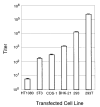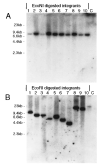Helper-free foamy virus vectors
- PMID: 9853518
- PMCID: PMC3010407
- DOI: 10.1089/hum.1998.9.17-2517
Helper-free foamy virus vectors
Abstract
Retroviral vectors based on human foamy virus (HFV) have been developed and show promise as gene therapy vehicles. Here we describe a method for the production of HFV vector stocks free of detectable helper virus. The helper and vector plasmid constructs used both lack the HFV bel genes, so recombination between these constructs cannot create a wild-type virus. A fusion promoter that combines portions of the cytomegalovirus (CMV) immediate-early and HFV long terminal repeat (LTR) promoters was used to drive expression of both the helper and vector constructs. The CMV-LTR fusion promoter allows for HFV vector production in the absence of the Bel-1 trans-activator protein, which would otherwise be necessary for efficient transcription from the HFV LTR. Vector stocks containing either neomycin phosphotransferase or alkaline phosphatase reporter genes were produced by transient transfection at titers greater than 10(5) transducing units/ml. G418-resistant BHK-21 cells obtained by transduction with neo vectors contained randomly integrated HFV vector proviruses without detectable deletions or rearrangements. The vector stocks generated were free of replication-competent retrovirus (RCR), as determined by assays for LTR trans-activation and a marker rescue assay developed here for the detection of Bel-independent RCR.
Figures






Similar articles
-
The human foamy virus internal promoter is required for efficient gene expression and infectivity.Virology. 1995 Jan 10;206(1):601-10. doi: 10.1016/s0042-6822(95)80077-8. Virology. 1995. PMID: 7831816
-
Identification and functional characterization of a high-affinity Bel-1 DNA binding site located in the human foamy virus internal promoter.J Virol. 1998 Jan;72(1):504-11. doi: 10.1128/JVI.72.1.504-511.1998. J Virol. 1998. PMID: 9420252 Free PMC article.
-
Gene transfer using replication-defective human foamy virus vectors.Virology. 1997 Aug 18;235(1):65-72. doi: 10.1006/viro.1997.8658. Virology. 1997. PMID: 9300037
-
Regulation of gene expression by human foamy virus and potentials of foamy viral vectors.Stem Cells. 1997;15 Suppl 1:141-7. doi: 10.1002/stem.5530150818. Stem Cells. 1997. PMID: 9368334 Review.
-
Human foamy virus: an underestimated neuropathogen?Brain Pathol. 1992 Jan;2(1):61-9. Brain Pathol. 1992. PMID: 1341948 Review.
Cited by
-
Successful treatment of canine leukocyte adhesion deficiency by foamy virus vectors.Nat Med. 2008 Jan;14(1):93-7. doi: 10.1038/nm1695. Epub 2007 Dec 23. Nat Med. 2008. PMID: 18157138 Free PMC article.
-
In-Vivo Gene Therapy with Foamy Virus Vectors.Viruses. 2019 Nov 23;11(12):1091. doi: 10.3390/v11121091. Viruses. 2019. PMID: 31771194 Free PMC article. Review.
-
Progresses towards safe and efficient gene therapy vectors.Oncotarget. 2015 Oct 13;6(31):30675-703. doi: 10.18632/oncotarget.5169. Oncotarget. 2015. PMID: 26362400 Free PMC article. Review.
-
Cancer gene discovery: exploiting insertional mutagenesis.Mol Cancer Res. 2013 Oct;11(10):1141-58. doi: 10.1158/1541-7786.MCR-13-0244. Epub 2013 Aug 8. Mol Cancer Res. 2013. PMID: 23928056 Free PMC article. Review.
-
Historical perspective of foamy virus epidemiology and infection.Clin Microbiol Rev. 2001 Jan;14(1):165-76. doi: 10.1128/CMR.14.1.165-176.2001. Clin Microbiol Rev. 2001. PMID: 11148008 Free PMC article. Review.
References
-
- ACHONG BG, MANSELL PW, EPSTEIN MA, CLIFFORD P. An unusual virus in cultures from a human nasopharyngeal carcinoma. J. Natl. Cancer Inst. 1971;46:299–307. - PubMed
-
- BIENIASZ PD, ERLWEIN O, AGUZZI A, RETHWILM A, MCCLURE MO. Gene transfer using replication-defective human foamy virus vectors. Virology. 1997;235:65–72. - PubMed
Publication types
MeSH terms
Substances
Grants and funding
LinkOut - more resources
Full Text Sources
Other Literature Sources

